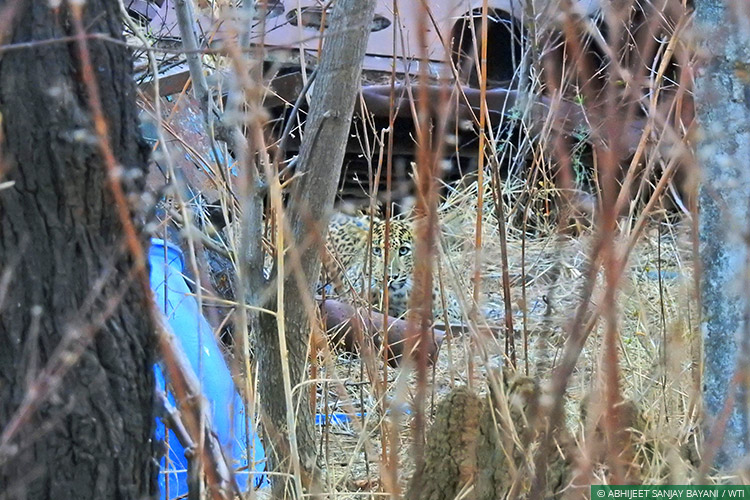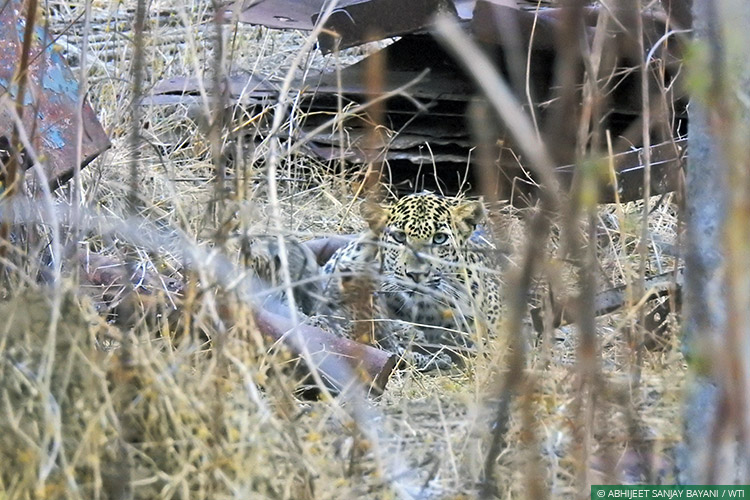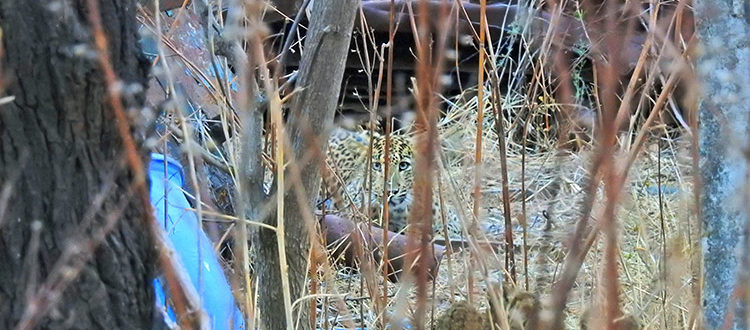The Junkyard Leopard
By Dr Abhijeet Sanjay Bayani

Working in the field in Wildlife Trust of India’s Vidarbha Tiger Project in Central India, you learn quickly that it’s a rare day when Nature doesn’t completely surprise you in some way.
One fine day when Nikhil – my colleague Nikhil Dandekar, a Field Officer with the project – and I were returning from our daily field surveys in a beautiful deciduous Terminalia-dominated forest in Brahmapuri, a local villager walked up to us and asked, “Are you wildlife enthusiasts?” Perhaps looking at our perspiring faces, mud-coated olive green clothes and the ‘wildlife-defining’ equipment tied around our necks, he had figured out our occupation!
Exchanging a glance, we answered in unison, “Yes?”
“We villagers these days see a waagh nearby quite frequently”, he said. “Are you aware of its presence?”
We exchanged glances once more and with slightly flabbergasted expressions answered, “No… where did you see it?”
The villager told us where the waagh was to be found and went about his work. We were left with the question: “What was that all about?!”
We decided that we had to have a look at the place he had described to us at least once, and the next moment we were headed directly to it.
I moved towards the scrap with a nagging thought at the back of my mind: “Why would a royal cat choose to hang around in this kind of mess?”
The spot the villager had directed us to was in the middle of a harvested rice field beside a large canal. To our utter bewilderment, there was a large amount of metal scrap lying scattered around. It was a junkyard, where all heavily exhausted metal sheets retired from their service had been discarded. A house-like structure made up of rusty iron sheets was erected in the middle of the junkyard as well.
“Is this really the place or have we lost our way?” I asked Nikhil. He smiled and said, “No, no, I definitely drove us to the right place, though the villager didn’t mention the metal crop lying harvested here! Let’s search!”
We started our prowl, slightly scared, our hearts pumping. We decided to move in different directions: Nikhil preferred the more open areas where the big cat could be expected to leave some signs of its presence; I moved towards the scrap with a nagging thought at the back of my mind: “Why would a royal cat choose to hang around in this kind of mess?”
For the first 15 minutes we did not find anything. Nikhil moved swiftly through the field, hoping to find some indication that there was a big cat in the vicinity. I moved slowly, searching each gap under the metal stacks. I also checked the rusty ‘house’ but came back disappointed. Then, just as we were about to abandon the search, I heard soft growls emanating from a spot quite close to me.
I called out softly to Nikhil and he came running. “Some growling from this side”, I whispered to him, pointing towards a haystack. The very next moment Nikhil spotted the big cat: “There, there, there it is! It’s looking right at us, right at us!”
For first couple of minutes I couldn’t see the cat. Nikhil grabbed hold of my head and placed it in the right position to look. And then I saw it: I was expecting a waagh, meaning a tiger, but this was a leopard! It struck me then that local villagers refer to both the big cats as ‘waagh’!
We did not expect that a leopardess (for we soon saw that ‘it’ was a ‘she’) with such beautiful blue eyes would be sitting so comfortably in front of us. Neither of us moved an inch nor spoke a word; we were completely under her spell. After a short while, having clicked a couple of photographs, we decided to move back.
And then, to boost our sense of exhilaration, two small cubs arrived at her side and started to play with each other! Their mother kept a careful eye on them and on us as well. After watching for about a minute we left the area, our hearts satisfied.

Nikhil and I had read previously how camouflage and adaptability are the keys to the common leopard’s success as a stealth predator across varied habitats in India. This leopardess and her progeny had given us a live demo of this notion, having taken up residence in a junkyard full of scrap metal.
The active forest guards as well as residents of nearby villagers are aware of her presence and the fact that she has two dependent cubs. Forest department officials, farmers and workers conducting repairs on the canal told us that she has been in the scrap yard for over a month. In fact, at the time of writing, she is still there!
Wildlife conservation requires a great deal of support from communities that live on the fringes of protected forests. In this case the villagers have shown an exemplary attitude.
While talking to the sarpanch (village head) of one of the villages in the area, we realised that not only are the villagers aware that the leopardess and her cubs are in the vicinity, they know that she may one day kill their livestock. That would be a terrible outcome since it could cause a panic and create a negative image in the villagers’ minds about big cats in general.
For the moment, though, they have shown a lot of courage and restraint by letting the leopardess live in the area. They have not only approached the forest department for help and monitoring but have also made a point not to disturb her. Farming activities in adjoining fields, which would otherwise have begun as soon the monsoon arrived, have been delayed. The contractor who was supposed to collect the scrap metal has also suspended his activities in order to leave her and the cubs in peace.
Wildlife conservation requires a great deal of support from communities that live on the fringes of protected forests. In this case the villagers have shown an exemplary attitude, patiently listening to the instructions given to them about their safety and the safety of the animals, and accepting the leopardess as their neighbour. What the future holds we cannot know, but for now she and her cubs are safe!
The author is a Field Officer and Biologist with Wildlife Trust of India’s Vidarbha Tiger Project.









